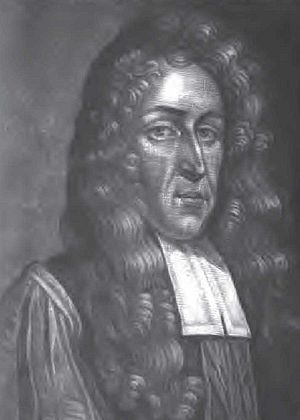Richard Langhorne facts for kids
Quick facts for kids BlessedRichard Langhorne |
|
|---|---|
 |
|
| Martyr | |
| Born | c. 1624 Little Wymondley, Hertfordshire, England |
| Died | 14 July 1679 (aged 54–55) Tyburn, London, England |
| Honored in | Roman Catholic Church |
| Beatified | 15 December 1929 by Pope Pius XI |
| Feast | 14 July |
Richard Langhorne (around 1624 – 14 July 1679) was an English lawyer and a Catholic martyr. He was wrongly put to death because of a made-up story called the Popish Plot. People suspected him because he was a Roman Catholic and helped Jesuits (a group of Catholic priests) with legal advice. This happened during a time when many people were very afraid of Catholics.
Early Life and Background
Richard Langhorne was born around 1624. He was the third son of William Langhorne, who was also a lawyer. His mother was Lettice Needham. They lived in Little Wymondley in Hertfordshire, England.
Richard became a lawyer in November 1654. He was a Roman Catholic and often gave legal and money advice to the Jesuits. After the Great Fire of London in 1666, there was a lot of fear about Catholics. Richard was briefly arrested but was soon set free.
His wife, Dorothy Legatt, was a Protestant. His two sons, Charles and Francis, both became priests.
The Popish Plot and Arrest
In 1678, a man named Titus Oates made up a huge lie called the Popish Plot. He claimed there was a secret plan by Catholics to kill King Charles II. This story was completely false.
Because Richard Langhorne was a Catholic and helped the Jesuits, he quickly became a suspect. He was arrested just a week after some priests were taken to prison. Even though there was no proof he had done anything wrong, he was put in Newgate Prison. He was accused of treason, which means trying to harm the King or country. Oates and another person named William Bedloe claimed that Richard's letters were about this made-up plot to kill the King.
Trial and Execution
Richard Langhorne's trial took place on 14 June 1679. He had to defend himself because, at that time, people accused of treason were not allowed to have a lawyer. He tried to show that Oates and Bedloe were not trustworthy. Many people knew these two men had bad reputations.
Richard also brought students from St Omer's College to prove that Oates was not in London when he claimed to be. However, the crowd in the courtroom was very angry at Catholics. They made so much noise that the witnesses could barely be heard. Some witnesses were even attacked as they left the court.
The judge, William Scroggs, was very unfair to Catholic priests. But he was a bit more fair to Catholic ordinary people. He told the jury to be careful not to convict an innocent person. Still, Richard Langhorne was found guilty of treason.
Richard's wife asked for more time for him. He was given an extra month to sort out his clients' affairs. He was even offered a royal pardon (forgiveness from the King) if he would admit to the plot. Richard agreed to tell the King about all the Jesuit properties in England, but he always said he was innocent of any crime. He also wrote a long religious poem.
Richard Langhorne was put to death at Tyburn, London, on 14 July 1679. As he died, many people in the crowd were impressed by his bravery. Public opinion was slowly starting to turn against the Popish Plot.
Legacy
On 15 December 1929, Richard Langhorne was honored by Pope Pius XI. He was given the title of "Blessed." His special day, or feast day, is celebrated on 14 July, the day he died.
There is a beautiful stained glass window showing Richard Langhorne. You can find it in the Our Lady of Lourdes church in Harpenden, Hertfordshire.

